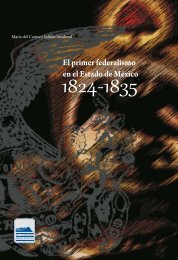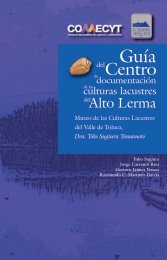Create successful ePaper yourself
Turn your PDF publications into a flip-book with our unique Google optimized e-Paper software.
KORPUS <strong>21</strong>, VOL. 2, NÚM. 4, 20<strong>21</strong>, 179-200<br />
Sanborns directors in Mexico City and Monterrey<br />
responded by transferring disloyal<br />
or unhappy employees to different store<br />
departments or by simply firing them all<br />
together. Evolving with postrevolutionary<br />
Mexico’s changing economic conditions,<br />
cultural production, and nationalistic trends,<br />
Sanborns owners thoroughly Mexicanized<br />
their store to increase their customer base<br />
beyond local elites and to promote foreign<br />
tourism. In the 1930s, a new folkloric Sanborns<br />
waitress uniform combined a selective<br />
appropriation of gendered clothing worn<br />
by Mexico’s indigenous populations. These<br />
uniforms further integrated working women<br />
under the company’s paternalism. It subjected<br />
them to perform their duties at work<br />
while their bodies displayed a romanticized<br />
stereotype of Mexico’s indigenous past. In<br />
the 1940s, a Sanborns company-controlled<br />
union further weakened labor protections<br />
for employees and provided another layer<br />
of control for store owners. These labor<br />
policies ultimately failed, however, because<br />
they created tensions among workers who<br />
felt increasingly vulnerable about their job<br />
security.<br />
This is a story about the labor experiences<br />
of women in the service and retail<br />
sector in Mexico City and Monterrey. It contributes<br />
to an understanding of the relationship<br />
between gender and c<strong>las</strong>s within the<br />
lived experience of Mexico’s working-c<strong>las</strong>s<br />
women (Hernández, 2017; Palacios, 2017;<br />
Porter, 2003; Fernández-Aceves, 2003;<br />
Lear, 2001). Focusing on Sanborns extends<br />
the historiography by including narratives<br />
from non-industrial workspaces in Mexico<br />
City and Monterrey. Gender historians have<br />
revealed how shifting public perceptions<br />
on gender, c<strong>las</strong>s, and the economy have<br />
shaped workforces and industrial paternalism<br />
(Farnsworth-Alvear, 2000; Lobato,<br />
1997; Weinstein, 1996; Wolfe, 1993). For<br />
example, factories were considered inherently<br />
masculine spaces, though with some<br />
notable exceptions (mainly in the textile industries).<br />
In Mexico, this was generally associated<br />
with jobs in manufacturing, industrial<br />
processing, and agriculture (Porter, 2003).<br />
Susie Porter analyzed the relationship between<br />
working women, discourses on morality<br />
and honor, and Mexico’s rapid industrialization,<br />
revealing that women worked<br />
primarily in Mexico’s cigarette and clothing<br />
industries. Mexican government administrators,<br />
led by Porfirio Díaz, turned to foreign<br />
investors from Europe and the United States<br />
to help stimulate a stagnating economy. By<br />
the turn of the century, favorable economic<br />
conditions led to expanding industrial production<br />
and an increase in mixed-sex urban<br />
factories. Interestingly, Porter notes how<br />
women’s work habits, consumption, and socializing<br />
“brought them into factories and<br />
public places in new ways” (Porter, 2003:<br />
xv). In the 1920s, Sanborns was considered<br />
a mixed-sex environment, and a popular<br />
space for elite sociability where Mexicans<br />
performed their identities and flaunted their<br />
wealth and power to one another. Working<br />
women at Sanborns played an integral role<br />
in defining these c<strong>las</strong>s identities. Their gender,<br />
physical appearance of their uniforms,<br />
and subordinate workplace positions became<br />
visual markers used by social critics<br />
and Sanborns directors to describe conceptions<br />
of modernity, sociability, and consumption<br />
in Mexico. My research shows that<br />
Sanborns stores are essential sites for understanding<br />
how U.S.-style consumer capitalism<br />
shaped everyday life and work within<br />
Mexico’s urban environments.<br />
María Teresa Fernández-Aceves’s (2003)<br />
analysis of female tortilla workers shows<br />
that the mechanization of corn mills in Guadalajara<br />
favored male employees over their<br />
female counterparts. Working women mobilized<br />
in unions and carved out political<br />
space for themselves by contesting gendered<br />
notions of female domesticity and<br />
motherhood enforced by the state, mill<br />
owners, and male workers. Fernández-<br />
Aceves challenges contending notions in<br />
labor histories viewing the labor movement<br />
as dominated by male actors, revealing the<br />
active participation of women in labor mobilization<br />
(Fernández-Aceves, 2003: 81-82).<br />
Her work also joins conversation with recent<br />
Latin American labor histories exami-<br />
181



![bicentenario_1[V2]](https://img.yumpu.com/68677971/1/167x260/bicentenario-1v2.jpg?quality=85)
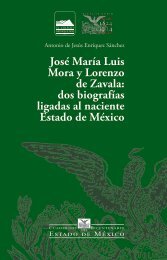
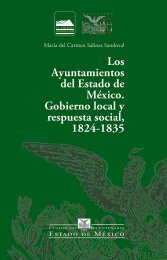

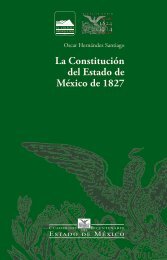
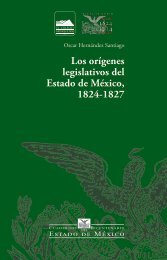
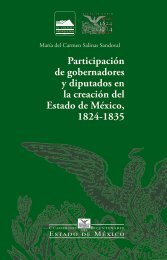
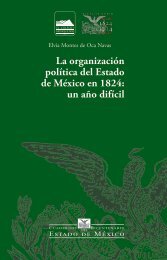
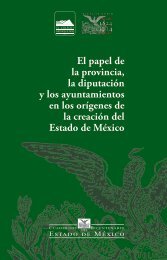

![El_primer_federalismoEM[final]_compressed (2)](https://img.yumpu.com/68483279/1/178x260/el-primer-federalismoemfinal-compressed-2.jpg?quality=85)
